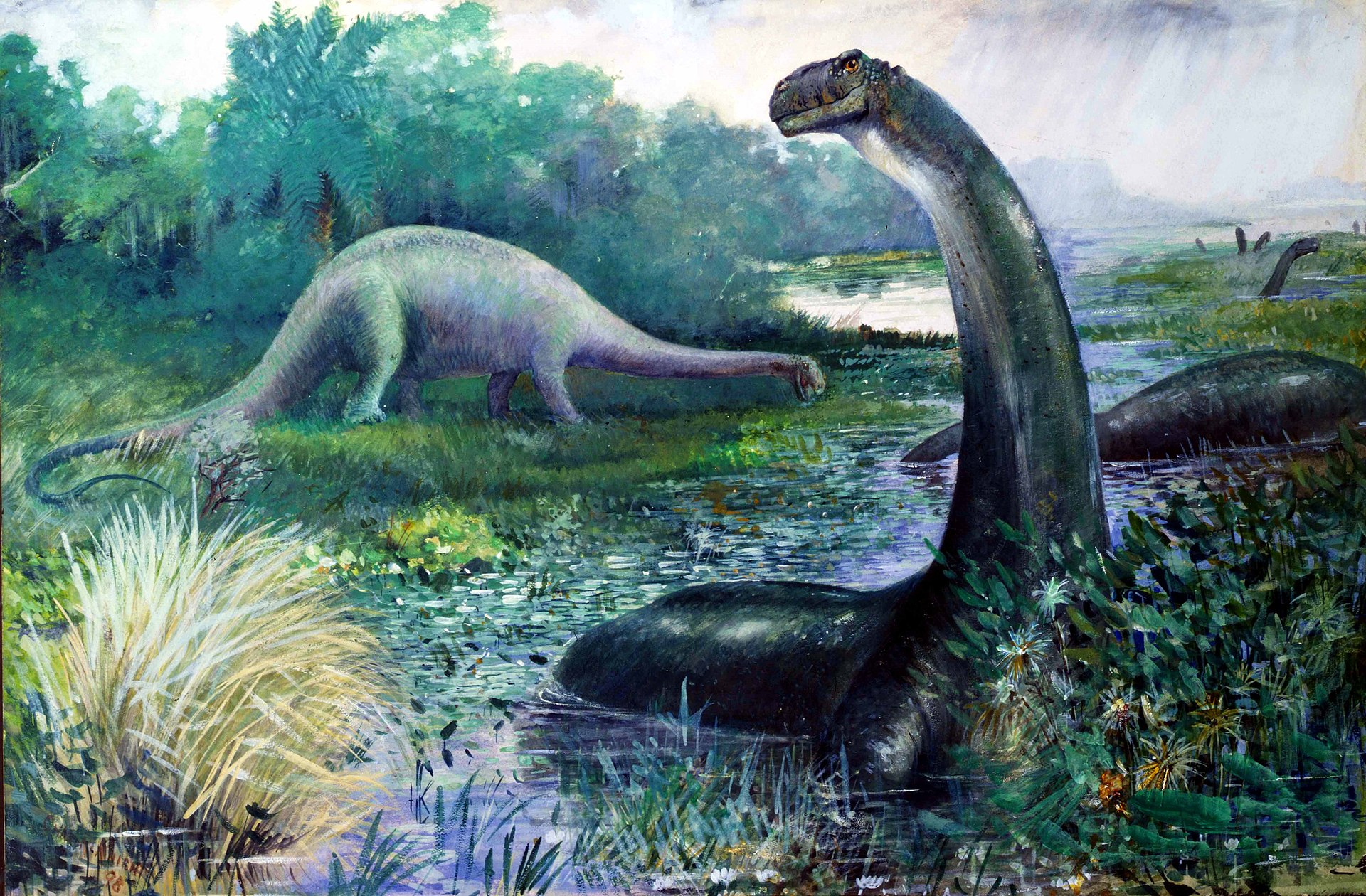 |
| Brontosaurus credit Charles R. Knight wiki |
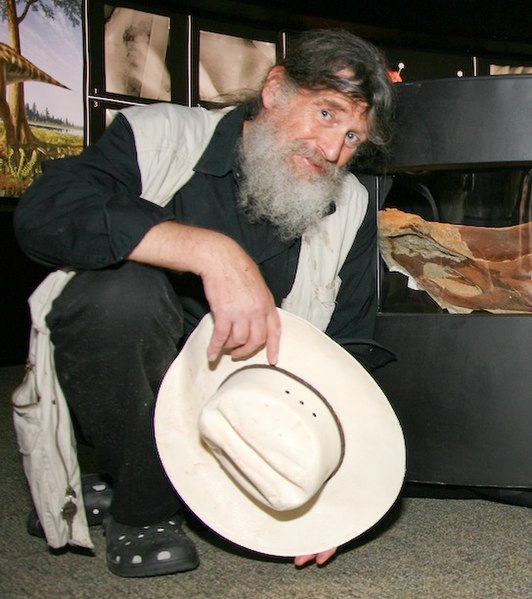 |
| Dr. Robert Bakker. wiki commons |
I do remember once hearing a profound Bakkerian quote from of course the inimitable Robert Bakker on dinosaurs in some dino doc I can't recall, to paraphrase; "There is a lot of explaining away going on with dinosaurs."
Now to focus on sauropods in particular let's look at how this group, right or wrong, has been "explained away" in particular throughout their history of study.
"They are so big and heavy that they could not support their weight on land"....
"With their puny teeth and head they could only subsist on soft water plant mush"....
"The preposterously long necks were a failed evolutionary experiment, dooming sauropods to evolutionary and ecological insignificance"....
"Their huge bulk and long ungainly neck limited them in maneuverability and they were easy pickings for any predator"....
"They could not raise their heads and neck above horizontal due to constraints imposed on the circulatory system getting enough blood to the head"....
"Sauropods were replaced by more sophisticated ornithischian herbivores in the Cretaceous"...
Now any student of sauropod knowledge should be aware that almost all of these claims have serious problems with them - and this "explaining away" of sauropods - especially by noted researchers - has throughout the history of thought on this group really established a number of pitfalls in arriving at the more nuanced understanding of this group that we have today. But what should not go unnoticed is that, with an economy of word change, almost all of these once cherished dogmatic"truisms" for sauropods, that have been more or less discounted over time, can be applied to plesiosaurs. And just how sauropods were often "explained away" despite their prolonged and spectacular evolutionary success so, likewise, have plesiosaurs been "explained away" despite their even longer relative tenure in the oceans.
"With their puny teeth and jaws, long necked plesiosaur could only subsist on small, soft bodied fish and squid"....
"The absurd necks of plesiosaurs, and especially elasmosaurs, were a failed evolutionary experiment - condemning them to ecological and evolutionary insignificance"....
"Their slow swimming speed, lack of maneuverability, and long vulnerable necks left them vulnerable to predators"....
"The plesiosaur neck was so stiff, weak, and inflexible that it imposed a significant burden on these animals for survival"....
"Plesiosaurs were replaced by the more advanced, aggressive, and dominant mosasaurs at the end of the Mesozoic"....
All right so a lot of the above interpretations I have dealt with before on several posts - especially concerning a wider foraging scope and potential defensive strategies - for this post I want to unpack that last one, a claim often made of plesiosaurs, that "plesiosaurs were replaced by the more advanced, aggressive, and dominant mosasaurs at the end of the Cretaceous".
As a bit of a primer let us address the claim which was often made of sauropods in the Cretaceous - that they were replaced by more advanced ornithischian herbivores (namely hadrosaurids and ceratopsids). This has been shown to be a complete farce with the advent of a more global survey of Cretaceous dinosaur faunas. Sauropods, most importantly the titanosaurs, actually held sway in Gondwana throughout the Cretaceous. It is in fact Laurasia, especially Laramidia, that is the anomaly with it's aberrant fauna of diverse ceratopsids and hadrosaurids. Take a trip to Maastrichtian Gondwana and you are going to be looking at sauropod dominated habitats. It has also been increasingly recognized that titanosaurs were making inroads into Laurasia by the end of the Cretaceous reclaiming lost territory. In retrospect it is not too difficult to parcel out why this paleontological faux pas occurred - some of the best Cretaceous dinosaur formations and most qualified researchers/amateurs/collectors of the time hailed from North America. Therefore the ornthischian dominated faunas of North America, especially Laramidia, were held up as the standard for what Cretaceous faunas looked like world wide - American exceptionalism. Time has not borne this idea out.
While the unique North American "Laramidia" fauna historically dominated much of our concept of what Cretaceous dinosaur fuanas "should" look like it is the Great Western Interior Sea that has most dominated thought on what late Cretaceous marine ecosystems "should" look like. And the biggest signal we get from the GWIS is that it was mosasaur country. Mike Everhart has documented the dominance of mosasaurs in the GWIS very well in several papers and articles on his Oceans of Kansas web site. Elasmosaurs, although present in the GWIS, typically form only a minority of the fossils pulled from the ground there - often attributed as 1% of the fauna by Everhart and others. Go further south along the gulf, Alabama, and the situation does not improve for elasmosaurs and mosasaurs are spilling out of the ground everywhere.
 |
| Some "medium" sized mosasaurs c/o Memo Koseman, from top-bottom Platecarpus, Clidastes, Plioplatecarpus, Halisaurus. used w/permission |
Maastrichtian Californian Elasmosaurs
What do we see on the other side of Laramidia along the putative coast of California (largely submerged) along the west coast of Laramidia? Wait, let's back up a bit - are you aware that California boasts a fairly decent roster of late Cretaceous marine reptiles? Yup even in the waning Cretaceous period going surfing in California was not without risk of being "tasted" by toothy predators. The best formation for marine reptiles is the Moreno formation of the San Jauquin valley representing a good transition from the Maastrichtian into the early Eocene. And just as the California coast today boasts significant upwelling of cold nutrient rich waters furnishing a robust food chain that attracts large pelagic megafauna - including blue whales - the proto-California coast (which would have been more inland coming against the rising Sierras) also seems to have been a productive area of upwelling hosting pelagic megafauna. We know this, because um well oil. From the abstract (AAPG, C. Fonseca 1996) "The hydrogen rich organic matter, high amount of biogenic silica and diatom assemblage in the Marca Shale (Moreno formation), indicate the latest Cretaceous coastal upwelling along the California margin resembles analog systems described from Recent and Neogene deposits along the Pacific coasts of North and South America." So it appears that during the latest Cretaceous early California already was characterized by the high productivity we see today. Additionally anoxic conditions were frequent (AAPG, C. Fonseca May 1996). Dedicated readers should recall that I suggested persistent bouts of anoxia inhibited large gill breathing predators (esp. sharks) allowing marine reptiles advantage to forage in such zones, especially as scavengers during mass die offs (Plesiosaur Machinations IV: He Is the Last You'll Know...).
 |
| Upwelling creates the conditions that puts dinosaurs in whale mouths. link |
 |
| Humpback whales, Heermann's Gulls, Brown Pelicans. credit Connie Tran. San Luis Harbor CA note the brown pelican stuck in jaws of whale |
*Update according to an abstract published Lindgren, Johan 2006 there were at least five genera of mosasaur swimming around in late Cretaceous California waters - Plotosaurus, Plesiotylosaurus, Globidens, Halisaurus, and Mosasaurus. ref CA Mosasaurs II: The Maastrichtian Moreno Formation Revisited. Second Mosasaur Meeting 2006.
I really like Ken Kirkland's take on Plotosaurus bennisoni. Kirkland does the illustrations for the book Dinosaurs and Other Mesozoic Reptiles of California which was a useful reference for this post. Especially fond of the incipient dorsal fin. Hey, why not? Tetrapods that return to the water converge on a number of anatomical features.
 |
| Plotosaurs bennisoni. (c) Ken Kirkland |
In fairness it should be noted that all four elasmosaurs were discovered and named by one individual Samuel Paul Welles in just one year!! Could there be a little redundancy here in number of species or genera? Most likely. However we still have more and better specimens of elasmosaurs than mosasaurs in the Moreno. Elasmosaurs were kicking butt right here when they should be at their lowest if we accept the premise that mosasaurs were outcompeting them. At least in California elasmosaurs seem to be doing better than mosasaurs!! (BTW the title of this post, senior water rights, is a play on the divisive rights to water that early settlers of CA maintain - from groundwater or river diversion - to this day in spite of our crippling drought.)
Instead let me suggest that we flip the script. Elasmosaurs held the longer tenure in the oceans and were better adapted to aquatic life than the relative new comers the mosasaurs. Elasmosaurs were choosing the best places to live in terms of ocean productivity. Let the mosasaurs have the warm shallow epicontinental seas, elasmosaurs like the cooler, richer, and deeper waters of continental shelfs i.e. areas of active oceanic upwelling. This idea of linking to elasmosaurs to areas of upwelling has been suggested before and I happen to endorse it. We will revisit it later.
Northern Plesiosaurs of the GWIS
Technically still part of the GWIS Canada's Bearpaw Formation, sometimes referred to as the Bearpaw Sea, My first real exposure to this interesting body of water was via - Dale Russell and his epic tome "An Odyssey in Time - Dinosaurs of North America". A book, though largely outdated in terms of dino science, does not get the credit it deserves for immersive text and attention to paleoecology. And despite the name of the book there is ample attention paid to the inland seas of North America with special reference to the marine reptiles (and Dale Russell has done a lot of mosasaur work too). With regards to plesiosaurs in the famed Kansas chalk of the GWIS Dale notes: "Only 1 percent of all the skeletal fragments of backboned animals belonged to plesiosaurs... Their skeletons are so uncommon in the chalk that those that have been preserved may have belonged to animals that were only migrating through the midcontinental sea (pp. 132)." This idea that plesiosaurs used the GWIS as a migration corridor is an idea that I have mentioned before and one that I happen to subscribe to. It is not without analogy given the many species of marine mammals that migrate to more equitable climes to give birth. Things get a little more interesting Dale notes as our gaze shifts northward to what is now known as the Smoking Hills Formation located in the northern territories near what is now the edge of the Beaufort Sea: "Platecarpus is the only known mosasaur, and Clidastes and Tylosaurus are either rare or absent. Plesiosaur remains are three times as abundant as those of mosasaurs, and nearly half of the specimens of air-breathing vertebrates collected belonged to Hesperornis. No remains of pterosaurs or marine turtles have yet been found (pp. 135)."Interesting to note that both sea turtles and mosasaurs are often rare or absent - this leads to suggestions that temperature may have played a role in the sorting of species there. Going further south into Alberta at the famed Dinosaur Provincial Park, which episodically records marine transgressions one of which is the Lethbridge Coal Zone Phil Currie notes that: "The marine reptile assemblage of the Lethbridge Coal Zone differs from that of the Bearpaw Formation in the abundance of plesiosaurs relative to mosasaurs. Although plesiosaurs are present in the Bearpaw formation, mosasaurs are more abundant. The reverse situation is seen in collections from the Lethbridge Coal Zone. This tendency for plesiosaurs to be more abundant in the more coastal settings suggests that elasmosaurid plesiosaurs were typically more coastal in their distributions than were mosasaurs (pp. 497 DPP: A Spectacular Ancient Ecosystem V1)."
I have to admit that I am not quite sold on elasmosaurs being primarily coastal as their worldwide distribution does not speak to that. And, has occurred several times when writing these machinations, synchronicity strikes again allowing me to embellish my point of what I think was often going on with their habitat preference. Recently published in Nature (Lea et al. 2015 link) the title pretty much explains it all: Repeated, long-distance migrations by a philopatric predator targeting highly contrasting ecosystems.
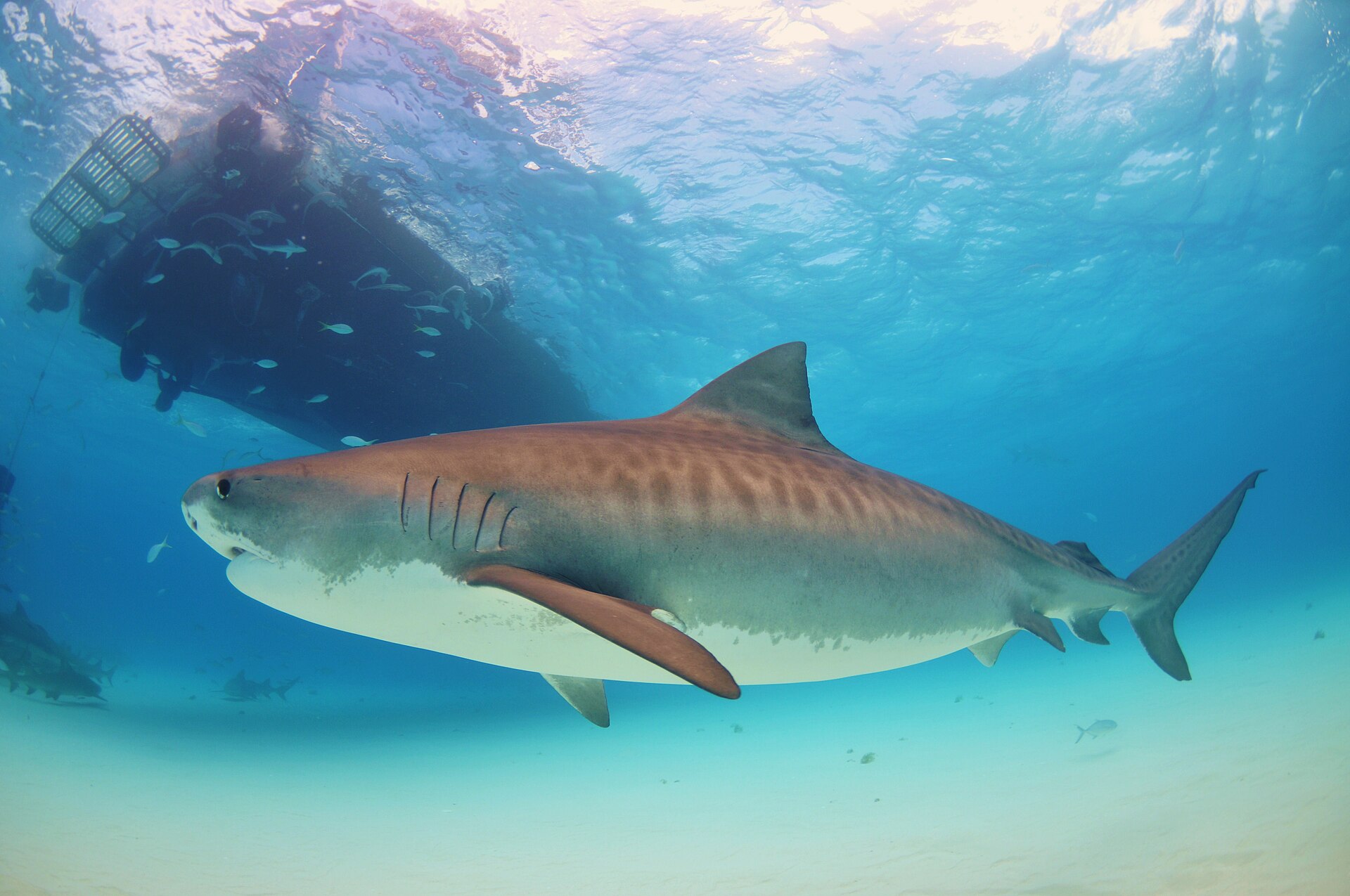 |
| Galeocerdo cuvier. Albert Kok. wiki |
"... adult males undertake annually repeated, round-trip migrations of over 7,500 km in the northwest Atlantic. Notably, these migrations occurred between the highly disparate ecosystems of Caribbean coral reef regions in winter and high latitude oceanic areas in summer..."
What should be iterated with regards to the tiger shark study is to keep in mind that prevailing thought is that the tiger shark is primarily a shallow water animal of reefs and the continental slope - not the middle of deep ocean basins. But when you think about it should we really be that surprised that a large pelagic animal spends time in several very disparate habitats and often migrates huge distances? Large pelagic animals travelling huge distance through variable habitats seems to be more the rule than the exception if you ask me; numerous cetaceans; pinnipeds; lamniforme sharks, especially noteworthy are white sharks i.e. "white shark cafe" etc etc; sea turtles, especially leatherbacks that target upwelling zones; many large fish, esp tuna. Such a movement pattern may have served numerous benefits for elasmosaurs; optimal temperature ; feeding opportunities; nursery grounds; predator/competitor mitigation. Note the last one is very pertinent with regards mosasaurs.
Size Race Between Mosasaurs and Elasmosaurs?
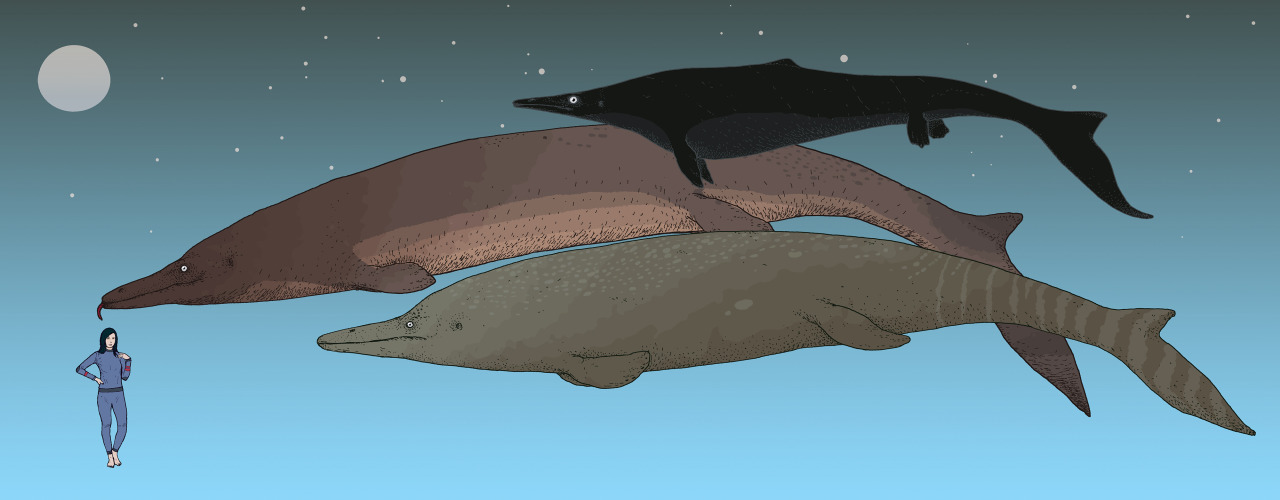 |
| credit Memo Koseman. Mosasaurs Blowing UP!! you can't handle the thickness from top to bottom Plotosaurus, Hainosaurus, Tylosaurus. used w/permission |
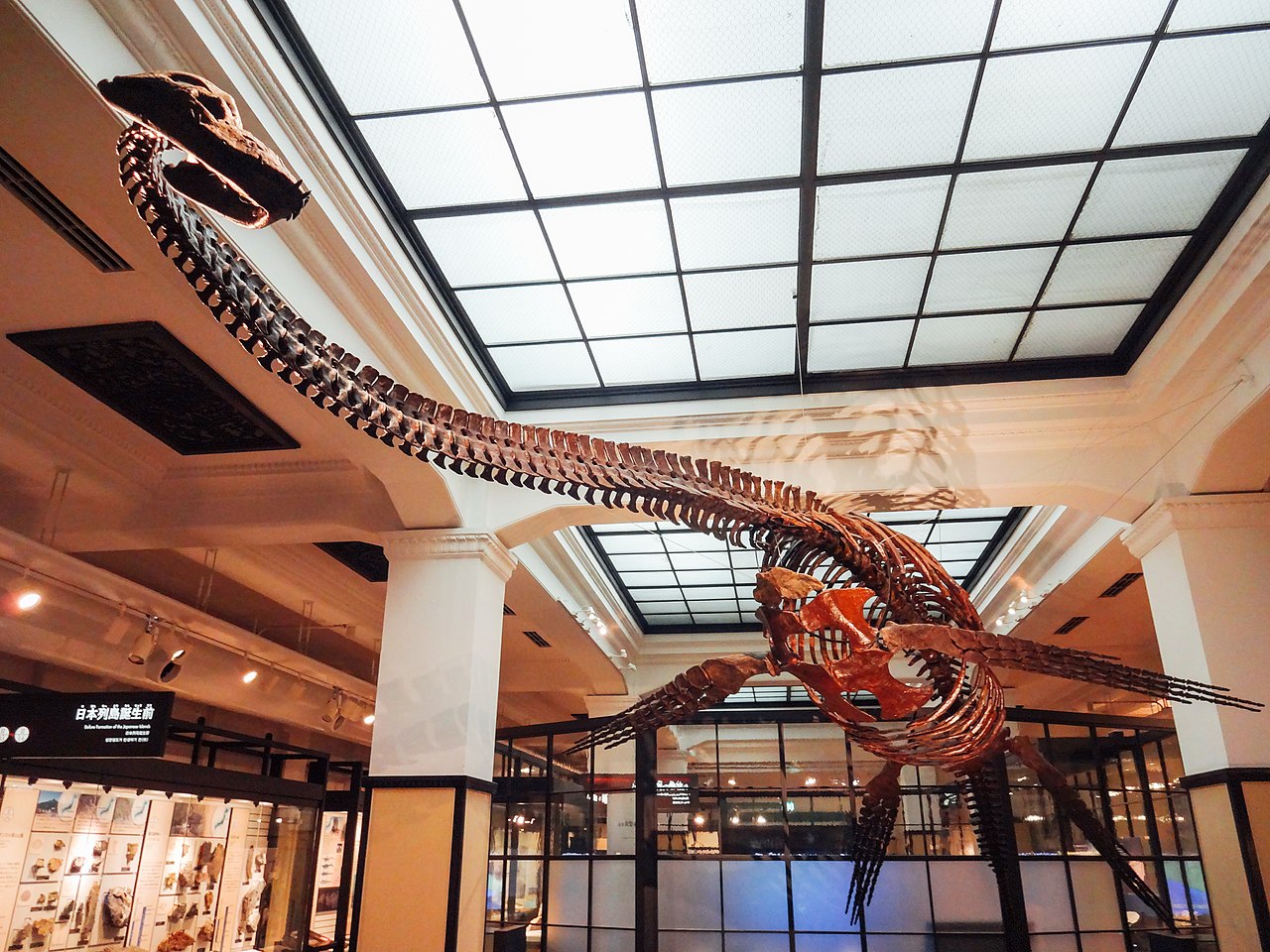 |
| Futabarasaurus credit Dick Thomas Johnson (LOLZ) CC2.0 |
And if we look at the Late Cretaceous and elasmosaur size there were some absolute bruisers in size. Elasmosaurus is usually quoted as the "largest" elasmosaur but I would caution with such sample sizes as we have and simply point out that there was a variety of late Cretaceous elasmosaurs that probably clustered in the 10-14 meter range and several tons of mass; Elasmosaurus in the Campanian; Hydrotherosaurus Maastrichtian of California; Futabasaurus Santonian Japan; Mauisaurus Haumurian(?) New Zealand. Killing a large adult elasmosaur was likely no easy task. And the significant teeth and bite of large elasmosaurs coupled with the distinct possibility of social defense was likely a significant deterrent to predators. More so than that visual predators could not afford to have damage sustained to, let's say an eye, from a deft elasmosaurid defensive strike from that capable neck.
Worldwide Maastrichtian Elasmosaur
I wanted to focus on these North American occurrences in particular because they are the most well studied. Turns out elasmosaurs are known from many places in the Maastrichtian - again not what we should expect if mosasaurs were displacing them. But if I can outsource my argument a bit I want to point to an obscure published "bulletin" that gives a pretty good review of elasmosaur distribution in the curtain call of the Cretaceous - the Maastrichtian. Elasmosaur Remains from the Maastrichtian type area, and a Review of latest Cretaceous Elasmosaurs (Reptilia, Plesiosauroidea) Mulder et al, 2000. Bulletin of Institut Des Sciences. pdf available online. In addition to what I have mentioned in California there are worldwide remains of elasmosaurs present in the Maastrichtian. Mulder et al. argue that the distribution and abundance of elasmosaurs was tied to upwelling and not to, as Bakker has argued, "dense algal forests" inhibiting their movements. So what Bakker has suggested is that basically kelp forests impeded elasmosaur movements in some areas. Kelp forests that we have no evidence for. Mulder et al. : "However, whether submarine vegetation barred plesiosaurs from epicontinental seas remains to be seen. The occurrence of plesiosaurs related to abundance of prey in oceanic upwelling areas is at least as plausible an explanation." and "From the distribution of Maastrichtian elasmosaurids worldwide it may be cocluded that , like mosasaurs, elasmosaurids were still widespread and diversified during the latest Maastrichtian... Even if precise stratigraphical extensions are often difficult to obtain for large vertebrate remains the extinction of elasmosaurids at the K/T boundary thus appears to be sudden rather than gradual."
So yeah, I agree with Mulder et. al. over Bakker at least here (see - I am not a total Bakker fan boy). Isn't it often said that great white sharks do not swim or hunt within kelp forests (interesting discussion)? And this pattern is what we see today with many of the oceans most dynamic and wide ranging high trophic consumers. Numerous whales, great white sharks, leatherback sea turtles, elephant seals - they all migrate vast distances to nursery grounds and/or high quality feeding grounds. The paucity of elasmosaur remains in many areas speaks to their ephemeral occurrence in these areas as they are simply passing through to more choice habitats. While mosasaurs were becoming more specialized towards the end of the Cretaceous to suggest that they were displacing elasmosaurs is not borne out by the evidence of plesiosaurs coexisting alongside mosasaurs for over 35 million years right up until the end of the Cretaceous.
Again moral of the post - where elasmosaurs are found seems to be correlated with upwelling and not mosasaur exclusion (not my idea but I agree with it). Certainly not an exhaustive survey on the subject but hopefully this post encapsulates the argument well enough.
And so to illustrate the bad-assery of elasmosaurs holding their own against the sea-lizards I depicted what is probably the second most iconic prehistoric clash after T-rex and Triceratops, a hypothetical encounter between a bivouac of Elasmosaurus platyurus and a marauding pair of Tylosaurus proriger. I imagine the mosasaurs travelling northward as the southern portions of the interior sea dries up. The elasmosaurs are holding up in a nice, productive rudistid reef full of tasty chondricthyans, shellfish, colonial crinoids, and crustaceans to eat in the Bearpaw Sea. The elasmosaurs do not take kindly to the sea lizards' intrusions and let them know their displeasure in no uncertainty.
How come no one draws this match up anymore?
 |
| credit Duane Nash |
A quick note on reef like benthic structures and fauna. Rudistids are an under utilized reference for depictions of Cretaceous reefs. That is probably because good depictions are lacking. I used this page from Smithsonian and took some highly liberal interpretations regarding size. But they do add sort of an alien, "Gigeresque" sensibility.
 |
| "Elevator" Rudists. credit Mary Parrish/Smithsonian |
 |
| "Recliner" Rudists. credit Mary Parrish/Smithsonian |
 |
| credit Mary Parrish. Smithsonia |
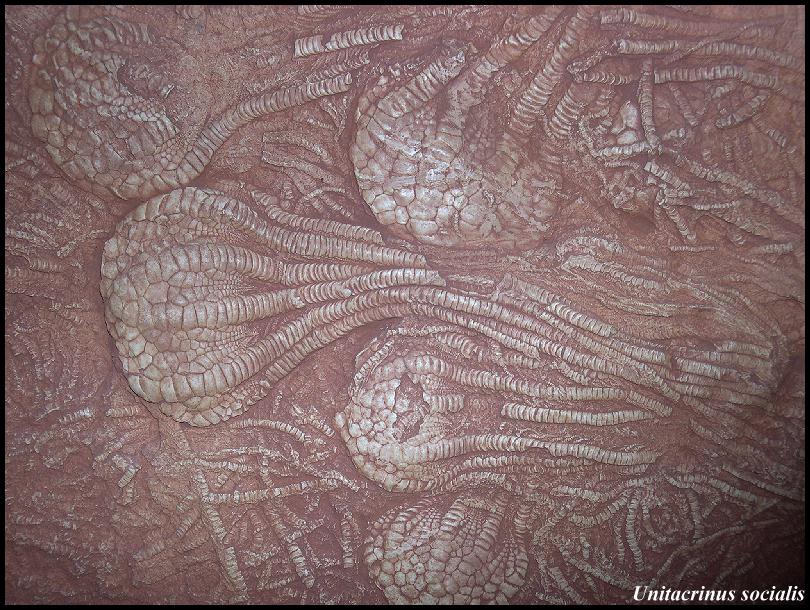 |
| Colonial Crinoid GWIS. Mike Everhart credit |
Cheers!!
Support me on Patreon.
Like antediluvian salad on facebook.
Watch me on Deviantart @NashD1.Subscribe to my youtube channel Duane Nash.
My other blog southlandbeaver.blogspot.










14 comments:
Nice.
I agree that the mosasaurs don't appear to be displacing the elasmosaurs but they were becoming very diverse in some areas towards the end of the Cretaceous; have a look at the number of species and genera there were in the Moroccan Maastrichtian.
Also not all of them had to swallow their prey whole, some species had developed flattened blade like teeth which would have been great for dismembering their prey.
And some of the large species like Mosasaurus hoffmanni seem to have had a wide distribution suggesting that they may have been migratory too.
Latest Cretaceous polycotylids though do seem to have been displaced, leaving the Elasmosaurs and the Mosasaurs as the top predators.
LeeB.
Been loving this series, and hope you continue.
I haven't been commenting as much as I should be (actually until now infinitely as much)
My only point of correction is you assert that Dr. Dale Russell is Canadian. He is in fact American, but this is easily excused as a large part of his career was at the Canadian Museum of Nature in Ottawa. ;)
Thanks for commenting/ I changed the bit about Dale Russell, I just always assumed thanks. Good point about the polycotylids - it seems like another morph that seems to have disappeared and reappeared several times in plesiosaur evolution a lot of early "pliosaurs" have some polycotylid traits, although my point of emphasis is on the "long neck" morphs i.e. elasmosaurs and I have not even touched upon aristonectines which some have pointed out as their own quasi radiation of specialized filter/trap predators of microfauna...
Elasmosaurids are traditionally characterized as having 40+ cervical vertebrae (among other things) but it is important to keep in mind the diversity of overall size, cervical count, and vertebral dimensions of this clade. Body sizes range from 5-14 meters in length and 43 to 76 cervical vertebrae.
Keep an eye out for my paper later this year (hopefully) with Druckenmiller and Benson on a new Bearpaw elasmo as well as the most complete phylogenetic analysis of Elasmosauridae to date.
The Bearpaw has (to my knowledge) 2 published and 4 other different species, if not genera, of elasmos.
Also, most researchers agree that 'Aphrosaurus' is a juvenile.
Yes Aristonectines have started to show quite a few different species in Antarctica, Southern South America, New Zealand and Angola recently.
There must have been an abundant food source available for them.
I wonder if anything similar evolved up in the Arctic at the same time.
I will have to watch out for the new paper, it will be good to see a comprehensive phylogenetic analysis of elasmosaurs.
LeeB.
Thanks for comment DanielleSerratos and I look forward to and have beard the rumors of some new elasmo material from the north!! I have a feeling that there were two or three Cretaceous elasmo families occurring in the Cretaceous.
@anonymous Yes there probably was an abundant small animal food source for aristonectines, especially in upwelling areas. I have read krill go back to the Cretaceous based on DNA time clocks but their fossil record is nonexistent. But any number of crustacean types, fish, cephalopods, could have provided such a food base. Maybe even tunicates, jellies!!
Quite a few of the larger mosasaurs (including Hainosaurus) have serrated dentition, you may want to rethink the idea they were limited to whatever they could swallow...
Good point Bk Jeong - i did not mean to imply that mosasaurs could not break down larger prey to consume only that they have extreme adaptations to swallow quite large meals and the preponderance of stomach remains suggests as such i.e. afaik no broken up bodies of prey preserved inside mosasaurs. But yes I can easily imagine both serrated and non-serrated toothed mosasaurs breaking down larger meals in any number of ways...
According to this (http://oceansofkansas.com/2ndMosaMtg/Abstracts.pdf, p.15) five genera of mosasaurs are now known from California: Plotosaurus, Plesiotylosaurus, Prognathodon, Mosasaurus and Halisaurus.
Thanks for drawing my attention to this RMW I will update the post with this info.
Anyone know anything about the Montana 'short-necked,long-necked plesiosaur' mentioned here:
https://www.uaf.edu/files/cnsm/CNSM-spring-web-2013-05-07-A-3-1.pdf, p.3
just rumors, murmurs nothing solid published yet... thanks for link though!!
"I seem to recall reading about an elasmosaurid paddle showing mosasaur bite marks somewhere but can't find the reference now, help anyone?"
Your mosasaur-bitten paddle may have been this one:
http://www.palarch.nl/wp-content/everhart_mj_bite_marks_on_an_elasmosaur_sauropterygia_plesiosauria_paddle_from_the_niobrara_chalk_upper_cretaceous_as_probable_evidence_of_feeding_by_the_lamniform_shark_cretoxyrhina_mantelli_palarchs.pdf
Mike Everhart has re-examined it and said the bite marks were more likely to have been made by a Cretoxyrhina shark. He also said that the elasmosaur specimen was a juvenile about 6m long. Incidentally Mike also claims that big sharks like Cretoxyrhina may have been exceptionally dangerous even to adult elasmosaurs, citing that plesiosaur fossils seem to have been most rare at the same time that Cretoxyrhina was around. Or at least, that's his interpretation of the fossil record.
Apart from that, one other noted example of predation on plesiosaurs; an elasmosaur skull bitten by the giant Kronosaurus:
http://www.academia.edu/download/1971919/Thulborn___Turner_1993_ModGeol.pdf
Thanks, please consider leaving a name though for better correspondence. If it is not yet obvious from my posts me and Mike don't agree on much as goes plesiosaurs/elasmosaurs. He is very insistent on them eating nothing bigger than fish of about 18" max while I suggest a more liberal range of food. Obvious I'm not in favor of a sharks, pliosaurs, or mosasaurs squeezing plesiosaurs/elasmosaurs into oblivion. They were around a long time for a reason - they were successful at living. Furthermore it's not like big sharks were the first macropredators plesiosaurs had to deal with. Before giant sharks they survived macropredatory ichthyosaurs, marine crocs, pliosaurs and kept right on going. I think Mike is just greatly influenced by what he sees in the Kansas chalk, which is that elasmosaurs are rare there. So what. Do we consider pinnipeds a failure because they are rare in most tropical oceans while dolphins abound there? Should we then conclude that dolphins and tropical sharks are outcompeting pinnipeds in the tropics because we don't see pinnipeds there? Maybe pinnipeds just prefer cooler waters?
Post a Comment